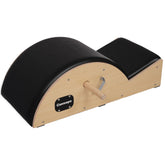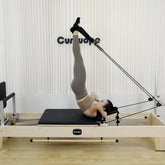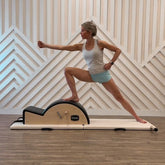Over 50s Pilates: Stay Fit and Healthy at Any Age
As we age, maintaining a healthy body becomes more important than ever. For individuals over 50, regular exercise is not only essential for physical health but also contributes to mental well-being. One of the best forms of exercise for this age group is Pilates. Known for its focus on strengthening muscles, improving flexibility, and promoting overall balance, Pilates offers a low-impact yet highly effective workout option. In this blog, we’ll explore why Pilates is the perfect exercise for those over 50 and how it can help you stay fit, healthy, and active at any stage of life.

Why Pilates?
Pilates is a form of exercise that was developed by Joseph Pilates in the early 20th century. It focuses on controlled movements, breathing techniques, and alignment to strengthen the core, improve flexibility, and enhance overall posture. Unlike high-impact exercises, Pilates is easy on the joints, making it an ideal choice for older adults looking to stay active without putting excessive strain on their bodies.
Pilates is also highly adaptable, meaning it can be modified to suit different fitness levels. Whether you are a beginner or an experienced athlete, there are exercises you can incorporate into your routine. It is particularly beneficial for individuals over 50 because it targets key areas such as core strength, flexibility, balance, and posture – all of which naturally decline with age.
Benefits of Pilates for Individuals Over 50
1. Improved Core Strength
Core strength is vital for maintaining good posture, stability, and balance. As we age, the muscles of the core tend to weaken, leading to a higher risk of falls and injuries. Pilates focuses on strengthening the muscles of the abdomen, back, and pelvis, providing a strong foundation for everyday activities. A strong core improves your ability to move freely and safely, helping to prevent the aches and pains often associated with aging.
2. Increased Flexibility
Joint stiffness is a common issue for people over 50, often due to a decrease in collagen and the natural aging process. Pilates incorporates movements that stretch and lengthen the muscles, improving flexibility and range of motion. As flexibility increases, you will notice a reduction in tightness and discomfort, making it easier to perform daily tasks and enjoy a wider range of activities.
3. Better Balance and Coordination
Balance tends to decline with age, increasing the likelihood of falls and injuries. Pilates exercises help to improve coordination and stability by focusing on controlled movements and body alignment. Many Pilates movements require you to engage multiple muscle groups at once, which enhances body awareness and balance. By practicing Pilates, older adults can reduce their risk of falls and improve their overall coordination.
4. Enhanced Posture
Maintaining good posture is essential for preventing back pain and other musculoskeletal issues, especially as we get older. Pilates emphasizes alignment and body awareness, which helps to correct poor posture habits. By strengthening the muscles that support the spine, Pilates promotes a more upright, aligned posture, reducing strain on the back and neck. This can lead to decreased pain and discomfort, improving your overall quality of life.
5. Stress Relief and Mental Clarity
Exercise, in general, is a great way to reduce stress and improve mental health. Pilates, with its emphasis on deep breathing and concentration, is particularly effective for calming the mind. The slow, controlled movements encourage mindfulness, helping you to stay focused on the present moment. This form of exercise can help alleviate anxiety, reduce stress, and improve overall mental well-being, leading to a greater sense of calm and clarity.
6. Low-Impact Exercise
As we age, it’s important to choose exercises that are gentle on the joints. High-impact exercises, such as running or jumping, can place strain on the knees, hips, and other joints, which may increase the risk of injury. Pilates, on the other hand, is a low-impact form of exercise that is easy on the joints while still providing a challenging workout. The controlled movements and focus on proper alignment ensure that you’re getting an effective workout without causing unnecessary stress on your body.
7. Improved Circulation
Pilates exercises encourage better circulation throughout the body. The combination of movement, deep breathing, and stretching helps to increase blood flow, which can reduce the risk of cardiovascular issues. Improved circulation also helps deliver oxygen and nutrients to the muscles, promoting overall health and vitality.
Starting Pilates After 50
If you’re new to Pilates or have never tried it before, starting a practice after 50 can seem daunting. However, Pilates is suitable for all ages and fitness levels, and there are a few simple steps you can take to ensure a safe and enjoyable experience.
1. Consult with Your Doctor
Before starting any exercise program, it’s a good idea to consult with your doctor, especially if you have any pre-existing health conditions or concerns. They can help you understand any limitations and provide recommendations on how to safely engage in physical activity.
2. Start Slow and Listen to Your Body
If you’re new to Pilates or exercise in general, begin with beginner-level classes or private sessions. It’s important to start slow and focus on learning the proper form and techniques. Pilates requires concentration, so give yourself time to adapt to the movements and listen to your body. Avoid pushing yourself too hard, and gradually increase the intensity as your strength and flexibility improve.
3. Use Props and Equipment
Pilates can be done on a mat, but there are also various props and equipment that can make the practice more accessible and beneficial. Equipment such as reformers, resistance bands, and exercise balls can be used to support the body, increase resistance, and provide assistance with certain movements. These tools can help you target specific muscle groups and challenge your body in new ways.
4. Take Classes with a Qualified Instructor
While it’s possible to practice Pilates at home using online videos or books, it’s highly recommended to take classes with a qualified Pilates instructor, especially if you’re just starting out. An instructor will be able to guide you through the exercises, ensure that you’re using the correct form, and offer modifications for any exercises that may be too challenging. Working with a trained professional can also help prevent injury and ensure that you’re getting the most out of your practice.
5. Stay Consistent
As with any exercise routine, consistency is key to seeing results. Aim to practice Pilates at least two to three times per week to experience the full benefits. Over time, you’ll notice improvements in your strength, flexibility, balance, and overall well-being.
Conclusion
Pilates is an excellent exercise choice for individuals over 50 looking to stay fit and healthy. Its low-impact nature, combined with its focus on strength, flexibility, and balance, makes it ideal for older adults. Whether you’re looking to improve posture, reduce stress, or increase flexibility, Pilates offers a safe, effective, and enjoyable way to stay active at any age. Remember to start slow, listen to your body, and enjoy the process of becoming stronger and healthier through Pilates.





